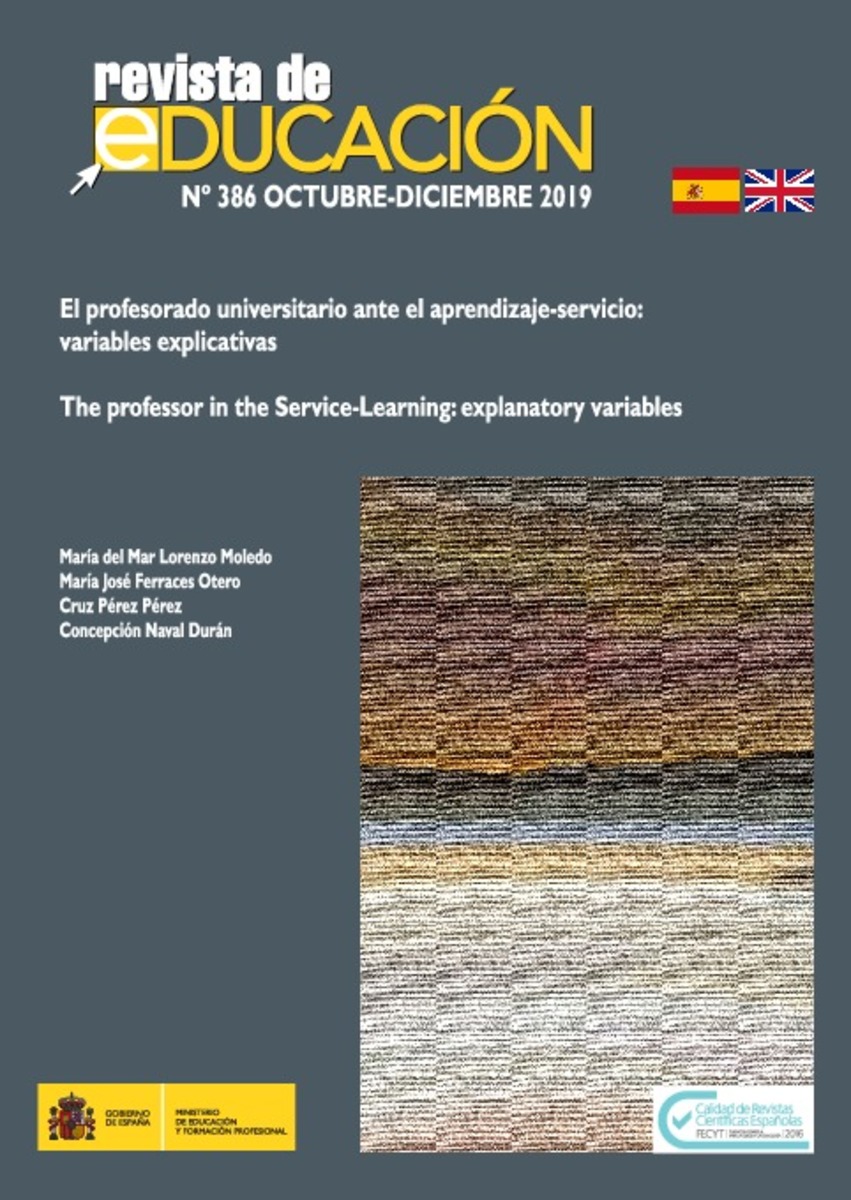Full metadata record
| DC Field | Value | Language |
|---|---|---|
| dc.creator | Lorenzo-Moledo, M. (Mar) | - |
| dc.creator | Ferraces-Otero, M.J. (María José) | - |
| dc.creator | Pérez-Pérez, C. (Cruz) | - |
| dc.creator | Naval, C. (Concepción) | - |
| dc.date.accessioned | 2020-02-20T10:31:08Z | - |
| dc.date.available | 2020-02-20T10:31:08Z | - |
| dc.date.issued | 2019 | - |
| dc.identifier.citation | Lorenzo-Moledo, M. (Mar); Ferraces-Otero, M.J. (María José); Pérez-Pérez, C. (Cruz); et al. "El profesorado universitario ante el aprendizaje-servicio: variables explicativas". Revista de educación. 386, 2019, 37 - 60 | es |
| dc.identifier.issn | 0034-8082 | - |
| dc.identifier.uri | https://hdl.handle.net/10171/58856 | - |
| dc.description.abstract | Introducción: La metodología del aprendizaje-servicio es una de las más adecuadas para adaptarse a los cambios y a los nuevos retos sociales y educativos en el espacio universitario. Se trata de un enfoque que promueve un aprendizaje de tipo experiencial en el que el protagonismo no está en el profesorado sino en quienes ofrecen y en quienes reciben el servicio. Las razones para proponer esta metodología en las aulas universitarias son muy variadas, y tienen que ver con la mejora de los procesos educativos, la formación ética y ciudadana del alumnado, así como con la mejora de los vínculos existentes entre universidad y sociedad. Concretamente, nuestro objetivo en este trabajo es analizar cuáles son las variables que explican que un profesor universitario introduzca la metodología de aprendizaje-servicio en su quehacer docente. Metodología: Con este propósito, hemos llevado a cabo un estudio con 1903 docentes de 6 universidades españolas a los que se les ha aplicado el “Cuestionario sobre Práctica docente y Actitud del profesorado universitario hacia la Innovación” (CUPAIN). Resultados: Con los datos obtenidos realizamos una regresión logística con la finalidad de estimar la probabilidad de que un profesor universitario utilice o no el aprendizaje servicio según variables sociodemográficas (sexo, edad, tipo de materia, alumnos matriculados, situación administrativa, experiencia, ciclo), la práctica docente, el acuerdo con el compromiso social de la universidad y el interés por prácticas docentes innovadoras; y, posteriormente, un análisis de varianza multivariado (MANOVA) 5 X 2, y una prueba chi-cuadrado. Discusión y conclusiones: El análisis de los datos nos permite concluir que de todas las variables analizadas la que mejor predice el empleo del ApS por parte de los docentes es su acuerdo con el compromiso social de la universidad, de tal forma que la probabilidad de utilizar esta metodología es 3.52 veces mayor que no hacerlo. | es_ES |
| dc.description.abstract | Introduction: The service-learning methodology is one of the most appropriate to adapt to changes, and new social and educational challenges in the Higher Education environment. This is an approach that promotes an experiential type of learning in which the teaching staff does not play a prominent role, but those who offer and receive the service. There are several reasons for proposing this methodology in the university classrooms, and they have to do with the improvement of the educational processes, students’ ethical and civic education, as well as with the improvement of the existing linkages between university and society. Specifically, our objective in this paper is to analyze which are the variables explaining the introduction of the service-learning methodology by a university professor. Methodology: To this end, a study involving 1903 professors from 6 Spanish universities was carried out. They were administered the “Questionnaire on Teaching Practice and Attitude of University Professors towards Innovation” (CUPAIN). Results: With the data obtained, a logistic regression was performed in order to estimate the probability that a university professor uses service learning according to sociodemographic variables (sex, age, type of subject, students enrolled, administrative situation, experience, cycle), teaching practice, agreement with the social commitment of the university and interest in innovative teaching practices; subsequently, a multivariate analysis of variance (MANOVA) 5 X 2, and a Chi-square test were applied. Discussion and Conclusions: The data analysis allowed us to conclude that, of all the analyzed variables, the one that better predicts the use of SL by the professors is their engagement with the university’s social commitment, in such a way that the probability of using this methodology is 3.52 times higher than not doing it. | es_ES |
| dc.description.sponsorship | Proyecto subvencionado nº EDU2013-41687-R. Proyecto de investigación de convocatoria competitiva del Ministerio de Economía y Competitividad, en el marco del Programa Estatal de I+D+i Retos de la Sociedad: “Aprendizaje-servicio e Innovación en la Universidad. Un programa para la mejora del rendimiento académico y el capital social de los estudiantes” co-financiado con Fondos Feder. | es_ES |
| dc.language.iso | spa | es_ES |
| dc.publisher | Ministerio de Educación, Cultura y Deporte. Secretaría General Técnica | es_ES |
| dc.rights | info:eu-repo/semantics/openAccess | es_ES |
| dc.subject | Aprendizaje-servicio | es_ES |
| dc.subject | Universidad | es_ES |
| dc.subject | Compromiso social | es_ES |
| dc.subject | Profesorado | es_ES |
| dc.subject | Práctica docente | es_ES |
| dc.subject | Service-learning | es_ES |
| dc.subject | University | es_ES |
| dc.subject | Social commitment | es_ES |
| dc.subject | Teaching staff | es_ES |
| dc.subject | Teaching practice | es_ES |
| dc.title | El profesorado universitario ante el aprendizaje-servicio: variables explicativas | es_ES |
| dc.title.alternative | The professor in the service-learning : explanatory variables | es_ES |
| dc.type | info:eu-repo/semantics/article | es_ES |
| dc.identifier.doi | https://doi.org/10.4438/1988-592X-RE-2019-386-426 | es_ES |
| dc.identifier.doi | 10.4438/1988-592X-RE-2019-386-426 | - |
| dadun.citation.endingPage | 60 | es_ES |
| dadun.citation.publicationName | Revista de educación | es_ES |
| dadun.citation.startingPage | 37 | es_ES |
| dadun.citation.volume | 386 | es_ES |
Files in This Item:
Statistics and impact
Items in Dadun are protected by copyright, with all rights reserved, unless otherwise indicated.






